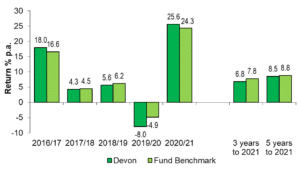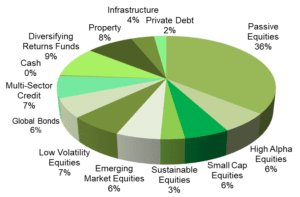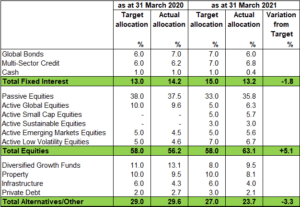Contents
County Treasurer’s Report
Introduction
Over the course of the 2020/21 year, the value of the Devon Pension Fund increased from £4.011billion (as at 31 March 2020) to £5.067 billion as at 31 March 2021, an increase of over £1 billion. Markets rebounded from the significant losses of March 2020 resulting from the coronavirus Covid-19 pandemic, despite the restrictions that continued for much of the year. As a result, the Devon Pension Fund’s investment return for the year, net of fees, was +25.6%. This was ahead of the Fund’s strategic benchmark of +24.3%, and also ahead of the LGPS universe average of +22.7%. This was a very good result for the fund after the performance of the previous year.
Along with nine other Local Government Pension Scheme (LGPS) funds, the Devon Pension Fund is a shareholder in the Brunel Pension Partnership Ltd, a company set up to pool investment assets in order to reduce investment costs and improve risk management. Since the company was set up three years ago the Devon Fund has been gradually transitioning its investment assets. During the Summer and Autumn of 2020, the Fund redeemed its investments in the Baillie Gifford and Barings diversified growth funds and these were transitioned to Brunel’s Diversifying Returns Fund. The Fund’s investment in five specialist equity funds was redeemed and transitioned to the Brunel Global Smaller Companies Equity Fund. At the same time an initial investment was made in Brunel’s Sustainable Equites Fund, which launched in October 2020. By 31 March 2021, around 80% of the Devon Fund’s investment assets were under Brunel’s management. The Devon Pension Fund will continue to be responsible for deciding the strategic allocation between different asset classes to meet local investment objectives, but the Brunel Pension Partnership will be responsible for selection and monitoring of the external investment managers who will manage the investments.
Peninsula Pensions continues to deliver strong performance in pensions administration. Staff have successfully adapted to the new ways of working, following the restructure in 2018/19, and have embraced the continuous improvement approach to processes which has been implemented. The team is well-positioned to manage and respond to the ever increasing workloads and demands caused by a growth in the number of members and employers joining the fund, increases in requests for information and to ensure continued compliance with future regulations changes. The situation with Covid-19 presented a significant challenge to the team; however, early action was taken to identify and mitigate potential risks from an operational perspective. Adopting a proactive approach to working processes and making greater use of technology and electronic communication, including ‘Member Self-Service’ (our online communication portal), have enabled the team to continue to conduct business as usual with no impact on service provision.
Summary of Financial Statements
The financial statements and their purpose are summarised as follows:`
- Fund Account – The Fund Account sets out the Pension Fund’s income and expenditure for the year to 31 March 2021. The first section sets out the income received in contributions from employers and employees, and the expenditure on pension benefit payments. The second section of the Fund Account shows the income received from the Fund’s investments and the cost of managing those investments. Investment income from listed equities and bonds is retained by the external investment managers for re-investment, but income from property, infrastructure and private debt is returned as cash and can be used to offset any shortfall between contributions and benefit payments. The Fund Account also shows that there has been an increase in the capital values of the Fund’s investment assets of £1.014 billion over the last year.
- Net Asset Statement – The Net Asset Statement sets out the net assets of the Fund, in line with the IFRS based Code of Practice on Local Authority Accounting in the United Kingdom (the Code) and the latest Statement of Recommended Practice (SORP). Pooled investments include pooled Equity, Fixed Interest, Property, Infrastructure and Private Debt Funds and they are incorporated into those categories in reviewing the Asset Allocation of the Fund in a later section of my report
Investment Performance
As indicated above, the asset value of the Fund at the end of the 2020/21 financial year was £5.067 billion. This represents an investment return of +25.6% net of fees, compared with the Fund’s internally set strategic benchmark target of +24.3%.
The Fund’s strategic benchmark is set as an average of the benchmarks for each of the investmentportfolios, weighted according to the Fund’s strategic asset allocation targets. Equity markets recovered dramatically from the falls in March 2020, and the passive equity allocation returned +37.5% over the year. Returns were helped by the Fund’s currency hedging strategy during a period when the value of the pound rose against other major currencies. The active Brunel Global High Alpha and Emerging Markets funds did even better, returning +50.0% and +46.1% respectively, both well ahead of the benchmark. Low Volatility Equities did less well against the wider market, in a period when low volatility stocks were generally out of favour. Global bonds delivered a small negative return, having delivered good positive returns in March 2020 when the rest of the market collapsed. The Wellington Multi-Sector Credit fund delivered a +24.8% return well ahead of benchmark.
Pension fund investment management has to consider the long term, and the Investment and Pension Fund Committee’s principal aim for the Fund is therefore to maintain high performance over the longer term. Performance over the last year has boosted the longer term returns, but they remain below benchmark over the three and five year periods. The following chart presents the investment returns achieved by the Devon Fund compared to the Fund’s benchmark over each of the last five years, plus the total annualised return over the last three years and the last five years. Performance Figures are shown net of fees.

Fund solvency
The Fund is required to have an actuarial valuation conducted every three years. The most recent triennial valuation, as at 31 March 2019, was carried out by the Fund Actuary, Barnett Waddingham. The valuation determined that the Devon Pension Fund’s funding level had improved from 84% to 91%, compared with the previous 2016 valuation.
The Fund Actuary has reassessed the position as at 31 March 2021, using the approach of rolling forward the data from the 2019 valuation, and updating it for subsequent investment returns, pension and salary increases and revised financial assumptions. While it is not possible to assess the accuracy of the estimated liability as at 31 March 2021 without completing a full valuation, the results will be indicative of the underlying position. The funding position was damaged by the negative returns in 2019/20, but the significant recovery of markets and the 25.6% return in 2020/21 means that since the 2019 triennial valuation the total return on the Fund assets has been ahead of the Actuary’s expectations.
The Actuary’s revised financial assumptions include a reduction in the assumed dividend yield going forward, which has reduced the discount rate applied and therefore increased the projected pension liabilities. This has offset the positive performance on the Fund’s assets resulting in an estimated funding level as at 31 March 2021 of 90%, broadly similar to the position at the 2019 triennial valuation.
Asset allocation
The Investment and Pension Fund Committee is charged with the responsibility for governance and stewardship of the Fund and making decisions about strategic asset allocation policy. The last major review undertaken by Mercer investment consultants in February 2019 recommended a direction of travel towards a long term target to be achieved by a phased implementation over a five year period, which would also tie in with the launch of new investment portfolios by the Brunel Pension Partnership. In line with that strategy, the Committee agreed the following changes to asset allocation targets during 2020/21:
- The allocation to global bonds and multi-sector credit was increased, funded by a reduction in the target allocation to Diversified Growth/Diversifying Returns funds
- The active equity allocation that comprised the investment in specialist funds was transitioned to the Brunel Smaller Companies portfolio.
- The Fund’s allocation to passive equities was reduced to fund an initial 3% allocation to Sustainable Equities and to increase the target allocation to Low Volatility Equities from 5% to 7%.
Further commitments have been made to private markets, including infrastructure, private equity and private debt. The aim is to build these up to 15% of the total fund, but it is recognised that this will take some time to achieve, as it can take a long time for commitments made to be drawn down. This will be funded by a gradual reduction in the allocation to the Brunel Diversifying Returns fund.


Conclusion
The priority of any pension fund is to make sure that it meets its liabilities to pay pensions both now and in the future. The COVID pandemic has provided challenges to both Peninsula Pensions and the Investments Team in continuing to provide the required level of service while most staff have been working at home. The commitment of staff has ensured that these challenges have been met.
Markets bounced back surprisingly quickly from the losses of March 2020, and the Fund’s investment return of 25.6% is a very positive result for the 2020/21 year. However, it remains a very challenging environment for the global economy and there may still be choppy waters ahead. We will need to ensure that the Fund strategy is well positioned to manage the short and medium-term risks, and will look to review the investment strategy over the next 12 months. We will continue to strengthen the Fund’s approach to climate change and responsible investment. The next triennial actuarial valuation is due as at 31 March 2022, and we will want to see continued progress to achieving full funding.
As at the 31st March 2021 80% of the Fund’s assets were managed by the Brunel Pension Partnership, with the transition of the fixed interest allocation due to take place during the Spring. This will take us up to nearly 95% of the assets being managed by Brunel. Following the County council elections there will be several new members of the Investment and Pension Fund Committee that is responsible for the management of the Fund. The Committee will continue to be focused on the Fund’s strategic asset allocation to ensure we can achieve our funding targets and continue to meet our liabilities to pay pensions over the medium to
longer term.
The Fund remains committed to ensuring that it provides an excellent service to pension fund members and value for money for both pension fund members and local taxpayers.
Angie Sinclair
Director of Finance, 15th November 2021
Summary Pension Fund Accounts
Fund Account
| 2020 £000 | 2021 £000 | |
|---|---|---|
| Contributions and benefits | ||
| Contributions receivable: | ||
| Employers | 207,397 | 171,456 |
| Employees | 40,758 | 42,805 |
| Transfers in from other schemes | 17,279 | 12,970 |
| Total | 265,434 | 227,231 |
| Benefits Payable | ||
| Pensions | (157,626) | (163,522) |
| Lump Sums | (27,170) | (24,617) |
| Death Benefits | (3,674) | (4,300) |
| Refunds | 14 | 586 |
| Transfers out to other schemes | (12,770) | (7,851) |
| Total | (21,226) | (200,876) |
| Net additions from dealings with Fund Members | 64,208 | 26,355 |
| Management Expenses | (19,732) | (20,791) |
| Return on Investments: | ||
| Investment Income | 59,351 | 35,020 |
| Change in market value of Investments | (394,994) | 1,015,231 |
| Net Return on Investments | (335,643) | 1,050,251 |
| Net Increase (Decrease) in the Fund during the year | (291,167) | 1,055,815 |
| Add: Opening Net Assets of the Fund as at 1 April | 4,302,282 | 4,011,115 |
| Net Assets of the Fund as at 31 March | 4,011,115 | 5,066,930 |
Net Asset Statement
| 2020 £’000 | 2021 £’000 | |
|---|---|---|
| Investments at Market Value | ||
| Fixed Interest | ||
| UK Public Sector Bonds | 13,721 | 11,144 |
| Overseas Government Bonds | 153,358 | 160,893 |
| Corporate Bonds – Global | 106,363 | 119,187 |
| Pooled Investments | 3,307,127 | 4,296,164 |
| Pooled Property Investments | 372,962 | 404,962 |
| Derivatives | (3,101) | 4,960 |
| Foreign Currency | 8,511 | 11,509 |
| Short Term Deposits and Cash Equivalents | 27,243 | 19,011 |
| Cash and Bank Deposits | 12,043 | 27,220 |
| Investment Payables and Receivables | 2,623 | 477 |
| Total | 4,001,277 | 5,056,295 |
| Long Term and Current Assets | 34,584 | 18,063 |
| Long Term and Current Liabilities | (24,746) | (7,428) |
| Net Assets of the Fund as at 31 March | 4,011,115 | 5,066,930 |
Current Investment Managers
Managers and Mandates
| Market Value 31 March 2021 £’000 | % of Total Investments % | |
|---|---|---|
| Brunel Pension Partnership | ||
| Passive Equities | 1,800,418 | 35.6 |
| Global High Alpha Equities | 314,878 | 6.2 |
| Global Small Cap Equities | 314,878 | 4.7 |
| Emerging Market Equities | 281,725 | 5.6 |
| Sustainable Equities | 153,375 | 3.0 |
| Low Volatility Equities | 336,892 | 6.7 |
| Diversifying Returns Fund | 476,194 | 9.4 |
| Property | 409,079 | 8.1 |
| Infrastructure | 65,840 | 1.3 |
| Private Equity | 1,333 | 0.0 |
| Lazard Asset Management | ||
| Global Bonds | 300,013 | 6.0 |
| Wellington Management | ||
| Multi-Asset Credit | 344,738 | 6.8 |
| DCC Investment Team | ||
| Specialist Equities | 46,769 | 0.9 |
| Infrastructure | 137,785 | 2.7 |
| Private Debt | 107,613 | 2.1 |
| Cash | 41,565 | 0.9 |